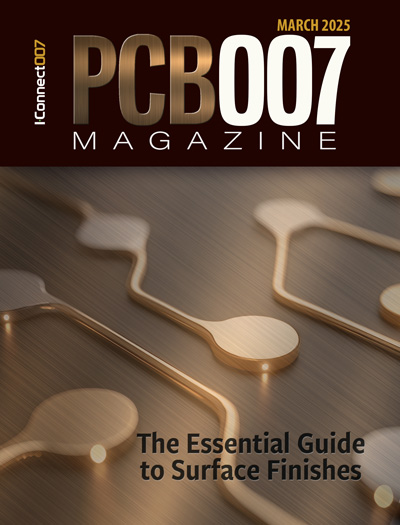-

- News
- Books
Featured Books
- pcb007 Magazine
Latest Issues
Current Issue
In Pursuit of Perfection: Defect Reduction
For bare PCB board fabrication, defect reduction is a critical aspect of a company's bottom line profitability. In this issue, we examine how imaging, etching, and plating processes can provide information and insight into reducing defects and increasing yields.

Voices of the Industry
We take the pulse of the PCB industry by sharing insights from leading fabricators and suppliers in this month's issue. We've gathered their thoughts on the new U.S. administration, spending, the war in Ukraine, and their most pressing needs. It’s an eye-opening and enlightening look behind the curtain.

The Essential Guide to Surface Finishes
We go back to basics this month with a recount of a little history, and look forward to addressing the many challenges that high density, high frequency, adhesion, SI, and corrosion concerns for harsh environments bring to the fore. We compare and contrast surface finishes by type and application, take a hard look at the many iterations of gold plating, and address palladium as a surface finish.
- Articles
- Columns
Search Console
- Links
- Media kit
||| MENU - pcb007 Magazine
Growth Ahead for Flexible Hybrid Electronics Industry
May 25, 2017 | Heidi Hoffman, SEMIEstimated reading time: 8 minutes
Introduction
According to Zion Research, “global demand for the flexible electronics market was valued at $5.13B in 2015 and is expected to generate revenue of $16.5B by 2021, growing at a CAGR of slightly above 21% between 2016 and 2021.” Key elements of the market, in the view of most analysts, include flex displays, sensors, batteries, and memory.
Figure 1: Global flexible electronic market revenue, 2015-2021.
Market research firm Gartner Group says that flexible electronics materials have progressed significantly over the past five years, as have manufacturing techniques, giving rise to increased expectations. The growth of IoT is helping to create many of the new opportunities. Small flexible power sources and sensors can help to drive compact and unique form factors for electronic devices. Health and fitness applications and OLED are markets demonstrating potential for growth as flexible devices and displays. Applications also abound in the automotive, consumer electronics, healthcare, and industrial sectors.
For flexible displays, technology readiness finally meets market demand, as flexible substrates and components become widely available to consumers. IHS estimated in 2016 that the flexible display market would average 27% CAGR over the next several years. In 2001, FlexTech (then the U.S. Display Consortium and now a SEMI Strategic Association Partner) and its members and partners recognized flexibility as one of the next big inflection points for displays and components and the need for collaboration among industry sectors as key to success.
To address that need, the Flexible Display Conference was born with 80 participants and continues this year as 2017FLEX–Accelerating Toward Manufacturing and expects over 600 attendees. The challenges have been considerable in adding flexibility to electronics which have been developed on stable and rigid substrates—attributes which have also constrained them to static and box-like packaging.
Commercializing the introduction of - not just displays - but the many other electronic components in flexible configurations continues as FlexTech’s core focus. The industry will collectively advance flexible electronics at the upcoming 2017FLEX conference and exhibition being held at the Hyatt Regency Hotel and Spa, Monterey, California, June 19-22.
Figure 2: Forecast for the flexible display market.
What is flexible, hybrid electronics?
According to FlexTech, Flexible Hybrid Electronics’ Information Hub, flexible electronics refers to electronic devices built on conformable or stretchable substrates, usually plastic, but also metal foil, paper, and flex glass. They enable a new class of electronics—ones that conform to any shape, but are also bendable, twistable, and/or stretchable. Taking advantage of the ability to conform to organic shapes, electronics can be incorporated into more useful and comfortable consumer and industrial products, capabilities, and features. Combined with rapid advancements in data analytics and artificial intelligence, they can bring digital intelligence to the greater world.
The term "hybrid" refers to designs, which have both printed components and advanced CMOS-based components, allowing the system to process data and activate commands, but also uses the most cost-appropriate componentry for the device. The manufacturing processes bring traditional handling and printing techniques from the paper printing industry: ink placement from heads designed for office printers, chemical formulations from the paint industry, micro- and nano-scale lithography from IC manufacturing, as well as pick-and-placement of die in continuous web processes.
The Return of Flex Displays
Brian Shieh, corporate VP and general manager of the Display Business Group at Applied Materials, says that, “development in the flexible display market is highly anticipated for the next generation of smart phones, tablets/phablets, and other communication devices.”
Companies like E Ink, Yole Développement, FlexEnable, the Holst Center, and SmartKem are deeply involved in this vision and are making progress on flexible electrophoretic displays and OLEDs. E Ink, for example, has created products utilizing flexible, bi-stable, low-power, electrophoretic displays (EPD) in a number of applications, including:
- a plastic 32-inch EPD for signage applications
- a Sony watch that uses a plastic thin film transistor (TFT) EPD for both the watch face and the watch band
- an autonomous 24-inch architectural tile powered by flexible solar cells and no battery
- a dress fabricated from flexible EPD media
- a 20-inch advanced color ePaper (ACeP) display that shows vivid, full color images produced with a display that incorporates a single un-patterned layer of electrophoretic ink, a single TFT backplane, and no front light
Figure 3: Very thin flexible batteries are being created on a variety of substrates, including flexible ceramic, glass and metal foil.
Mobile Power Initiative
MarketsandMarkets recently estimated that “the wearable technology market is expected to reach $51.6B by 2022 at a CAGR of 15.51% between 2016 and 2022.” If the power sources for these devices are, for example, 10% of the total cost, then the result is a $5B+ market opportunity for flexible batteries and energy-harvesting electronics. The opportunity rests on the fact that new wearable, IOT, and mobile products will not function without power.
FlexTech’s R&D program has created their Power Initiative, designed to create and improve the functionality, printability, and flexibility of power-producing components through contracts with several established and new industry players. ITN is making progress on an all solid-state, thin film lithium rechargeable battery. Custom Electronics is developing and manufacturing a very thin flexible battery. North Carolina State University is involved in energy harvesting, and ETRI in Korea is focusing on supercapacitors.
Figure 4: Flexible display technology continues to evolve as market pull increases.
Flexible and Stretchable Electronics
The manufacturing of flexible and stretchable electronics is an area focusing on maturing a robust process as new methods are being explored and developed by companies such as Flex and Jabil, global EMS providers, in collaboration with NextFlex, America’s Flexible Hybrid Electronics Manufacturing Institute. These organizations are taking on challenges such as water ingress problems, flexibility, stretchability, interconnection challenges, and the lack of acceptable standards for reliability testing. Emerging manufacturing technologies with nano-materials, low temperature soldering, stretchable conductors, printable power, and water resistant coatings are key areas for investigation.
Page 1 of 2
Suggested Items
Compal Posts Sales Report for May 2025
06/12/2025 | Compal Electronics Inc.Compal Electronics reported May 2025 consolidated revenue of NT$ 57,625mn, representing MoM decrease of 7.5% and YoY decrease of 25.4%. The accumulated revenue of 2025 was NT$319,021mn, representing YoY decrease of 9.9%.
Delta Thailand Hosts BOI Delegation and U.S. Media to Showcase Thailand’s Electronics Industry Ecosystem
06/12/2025 | Delta ThailandDelta Electronics (Thailand) Public Company Limited recently welcomed a delegation of U.S.-based media professionals and representatives from the Thailand Board of Investment (BOI) Office in New York on May 14 , 2025, at Delta Plant 5 headquarters in Bangpoo, Thailand, as part of a strategic initiative to highlight the strengths of Thailand’s growing electronics sector.
Neways, BAE Systems Hägglunds Sign Long-term Supplier Agreement
06/12/2025 | NewaysBy signing the LTSA, Neways and BAE Systems Hägglunds further cement the long-time collaboration that started more than 15 years ago when Neways first supported BAE Systems in delivering an early fleet of CV90 armored vehicles: a platform that has been ordered in over 1,900 vehicles globally.
Roll-to-Roll Technologies for Flexible Devices Set to Grow at 11.5% CAGR
06/11/2025 | GlobeNewswireAccording to the latest study from BCC Research, the “Global Markets for Roll-to-Roll Technologies for Flexible Devices” is expected to reach $69.8 billion by the end of 2029 at a compound annual growth rate (CAGR) of 11.5% from 2024 to 2029.
Rethinking How Operators Interface With the Line
06/11/2025 | Nolan Johnson, SMT007 MagazineJurgen Schmerler, CEO of WaveOn, reveals how AI and large language models are revolutionizing electronics manufacturing. By integrating AI with machinery, operators can access real-time, multimodal information for troubleshooting and maintenance, significantly reducing training time and enhancing efficiency. He discusses the industry's challenges, the customizable knowledge bases, and the future of proactive maintenance and process control.


